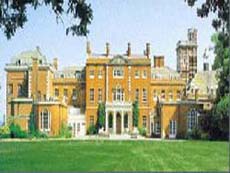Set in 55 acres of Wood and Parkland the venue combines elegance and grandeur of a Georgian Mansion House. Theobalds Park is situated 14 miles from the centre of London and 3/4 of a mile from junction 25 of the M25.
Theobalds Park History. Lady Meux died in 1910 and the property was left to Admiral Hedworth Lambton on condition that he changed his name to Meux. He subsequently agreed to this and during the following year, he sold the contents of the house by auction including, for 950, the carved Elizabethan oak staircase, which is now understood to be located within Hertsmonceux Castle. Sir Hedworth later became Admiral of the Fleet as well as a Member if Parliament. He carried out significant further alterations to Theobalds Park including its extensions northwards to create the Ballroom. Sir Hedworth died in 1929 and his widow then sold the property to be used as an hotel. In March 1937, the house was again put up for sale by auction although Temple Bar was excluded and retained by the trustees of Sir Hedworth Meuxs estate.This has now been re-located to Paternoster Square near its original site. The property failed to sell but was disposed of the following year in March 1938, being sold again within a month to the Middlesex County Council, for use as a general hospital pending the reconstruction of North Middlesex Hospital. Before the conversion could take place, war broke out in September 1939 and the house was requisitioned by the Metropolitan Police Riding School. Shortly after its return to the County Council, the London Borough of Enfield assumed responsibility, converting it for use as a school with its first pupils arriving in 1951. Theobalds Park continued to be used for secondary education until 1969 when the school was closed. Following its use as an Adult Education Centre during the 1970s and early 1980s, the borough council elected to convert and modernise it for use as a commercial conference centre as well as for its own management training and staff development. Planning permission was granted in 1990 for the restoration works and, where possible, all educational adaptations were stripped out with many of the original period features being restored to a notably high standard. In the summer of 1995, Initial Style Conferences acquired Theobalds Park. Theobalds Park now runs as a training and conference venue with 17 main training rooms and 14 syndicate rooms. There are 111 en suite bedrooms, leisure facilities and 55 acres of parkland. The earliest known reference to the Manor of Theobalds was in 1441 when it was granted to John Carpenter, Master of St Anthonys hospital. Records indicate it subsequently changed ownership several times over the following two hundred years prior to being purchased in 1563 by William Cecil, Lord Burghley, Secretary of State and Master of Requests to Edward VI and Elizabeth I. This transaction marked the beginning of an interesting and varied history with a number of Royals later visiting the property including Elizabeth I and James I, either as a final resting place prior to entering London or for hunting parties. A significant turning point in the fortunes of Theobalds Park came in 1763 when William, Third Duke of Portland, sold it to George Preston, MP, who immediately commenced the construction of a magnificent new house comprising the existing central section and the lower flanking wings. The Prescott family remained in the property until about 1820 when they leased it to Sir Henry Meux, a prominent London brewer. He died in 1841 leaving it to his son, also named Henry, who made a variety of major alterations including the addition of further wings either side of the central core. Henry later married Louisa Caroline Brudenell-Bruce, daughter of Lord Ernest Bruce MP and they subsequently produced a son and heir, Henry Bruce Meux, who married in 1878. His father died in 1833 shortly after the Trustees if Sir Henrys Estate sold the Freehold of Theobalds Park. In 1885, Henry Bruce Meux and his wife, Lady Meux, took up residence and during the following years they carried out a number of major works including a further extension to the south side together with, in 1887, the tower to accommodate a large water tank. During the same year, a new entrance gate was also created, involving the relocation from the City of London, Temple Bar, deigned and built in 1672 by Christopher Wren and weighing some four hundred tons. During this period, Lady Meux also added to the main house the Gun Room and Kitchen as well as a swimming pool and an indoor roller skating rink within the grounds.
Amenities and facilities24 hour security watch, Audio equipment, Coach parking, Dry Cleaning / Laundry Service, Flip Charts, Fully Equipped Gymnasium, Internet access, Jacuzzi, Meeting Facilities, Sauna, Steam Room.




